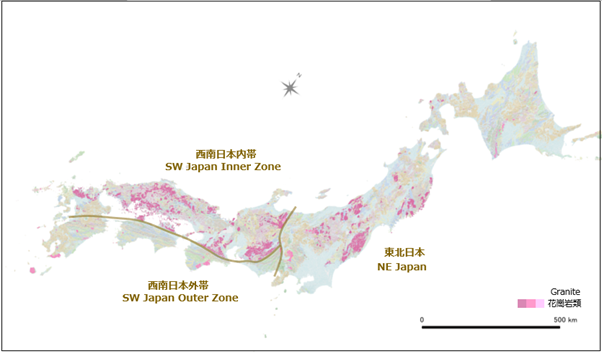1. Purpose of this survey
The geology of the Japanese Islands is very complex and consists of various types of strata and rocks. It tells us the geological history of the Japanese Islands for hundreds of millions of years. The Japanese Islands was located as part of the continent on the eastern edge of the Asian continent from hundreds of millions to 15 million years ago, and then separated from the continent and became an archipelago called the “island arc”.
The current Japanese Islands is roughly divided into northeastern Japan and southwestern Japan according to the characteristics of geological formations and rock distribution, and southwestern Japan is further divided into the Sea of Japan side (inner zone) and the Pacific Ocean side (outer zone). Geologically, the Japanese Islands is characteristically different in three zones, called “Northeastern Japan”, “the inner zone of Southwestern Japan”, and “the outer zone of Southwestern Japan”.

Distribution of granite (“Mikage-ishi”) and geological zones of Japan
By the way, the raw materials of sake are sake rice and brewed water, and these qualities basically have then very influence of sake. Generally, brewing water uses groundwater such as well water. The groundwater is what precipitation flows through the ground over days, months, years, and even decades. While it flows through underground formations and rocks, the components of the formations and rocks dissolve in the groundwater. In a word, the dissolved component (water quality) of underground water is decided by what kind of strata and rocks the water flowed, and how much time it took to flow.
The words “Nada’s Otoko Sake, Fushimi’s Onna Sake” has been known for a long time. This is famous as a word to express that the difference in hardness between hard water and soft water created the individuality of sake. Nada is located behind the Rokko Mountains, while Fushimi is located in the southern part of the Kyoto Basin. Rokko mountainous district is made of granite (that magma cooled and hardened) known by “Mikage-ishi”, and the mountainous districts around Fushimi are made of sedimentary rocks (deposited on the bottom of seafloor) of the Mesozoic and Paleozoic. This “Nada’s Otoko Sake, Fushimi’s Onnna Sake” is also a word that reflects the difference in geology that determines the water quality of groundwater.
As mentioned above, the diversity of groundwater in Japan can be regarded as a reflection of the geological complexity of the Japanese Islands. The purpose of this study is to unravel the relationship between geology and groundwater water quality in each region, while involving the geological history of the Japanese Islands. By elucidating the relationship, we will clarify the characteristics of water quality in each region, and grant the earth-scientific basis for local sake.
In this study, 11 regions are selected from the Japanese Islands arc excluding Hokkaido, and the groundwater quality components in each region are investigated. These regions were chosen from the distribution area of granite, the sedimentary rocks region of the Mesozoic and Paleozoic (called the accretionary prism), and the active volcano region, etc. In addition, the Shinano River (Chikuma River), the Tedori River, and the Kuzuryu River were also added to the survey area in order to obtain basic data on changes in the water quality of underlying water along major rivers.
